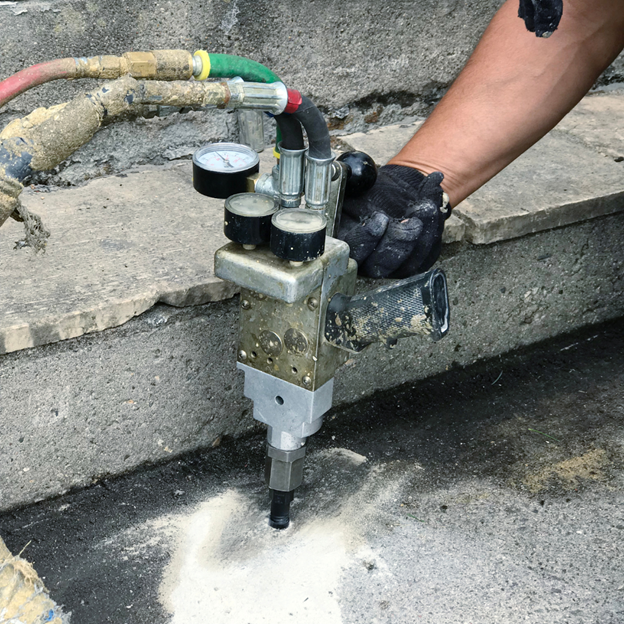Concrete is the most flexible building material, making up the majority of square footage used for construction projects on the ground and in the air.
There is presently no unbreakable concrete, despite developments in engineering and building. If concrete slabs line your patio, driveway, or pavement, you could occasionally see sunken areas.
Mudjacking cost can be a hefty price depending on who you hire for your job. But it is an investment that can only improve your quality of life. You can read more about mud jacking and all the alternatives in this post. Mudjacking allows you to have a level pathway by the end of the day instead of raising and replacing sunken slabs, as was the case in the past.
To see if mud jacking is the solution to your renovation job, keep reading.
What is Mudjacking?
Mudjacking, sometimes called slab jacking, is repositioning concrete slabs by drilling two-inch holes through which a concrete slurry of sand, cement, water, and occasionally dirt is injected. It was created in Iowa but rapidly became well-known as a less expensive option for fixing concrete slabs.
Using an infiltration mechanism, mudjacking raises a sunken slab by injecting slurry into cracks and crevices inside and beneath the concrete slab. As pressure builds up, the hollow slab is displaced upward.
The holes needed for mud jacking offer a way for the slab to weaken because of the slurry’s composition. Furthermore, you risk making things worse if you try to solve the problem independently without expert assistance.
The process of Mudjacking
Mudjacking might look straightforward at first, but this is rarely the case. Several measures must be taken to achieve the latter to get good outcomes. Further steps may be necessary depending on the severity of the damage to the concrete slabs, while others may not.
However, the following are the essential stages for each effort at mud-jacking repair:
Drilling holes
Pressurized holes with a one to 2.5-inch diameter inject the concrete slurry into the slabs. Before you can start converting your perfectly OK concrete slab into a temporary sieve, there are a few requirements.
Lift with slurry
Pumping the concrete slurry under the slabs is the next phase in the mud-jacking procedure. The slurry’s composition may vary. However, the most potent versions often contain the following ingredients:
- Cement
- Water
- Soil
- limestone filler
Hydraulic pressure produced by the setting slurry is necessary for lifting using slurry. With care exercised in the quantity provided to each hole, the previously bored holes are used to inject the concrete slurry. The amount of slurry pumped depends on how much lift is necessary to keep the slab level once the ride is finished.
The voids caused by shifting soil or extending roots are filled in by slurry poured beneath the slab and settled in between them. After filling the gap, more slurry produces a sizable hydraulic force that lifts the concrete slab.
Applying the finishing touches
A few additional measures are needed once the concrete slab is raised. All the effort you put into making your driveway attractive may be undone by weeds growing through the two-inch holes you made in the slab. Fill the holes and caulk any obvious gaps to ensure everything is in order.
In addition to ensuring that your repair is not unappealing, caulking the gaps stops further erosion by forces like wind and water that might deepen the cracks and generate weak points. After you are pleased with the results of the mud-jacking procedure, you should wait a few hours (the ideal time is 24 hours) before loading the concrete slabs.
To prevent having to remove extra concrete with a chisel while you wait, dealing with any spilled slurry while it is still wet is a good idea. Those oddly brilliant patches that the drilled holes left behind will regrettably not disappear as the day progresses. You should drape something across the driveway.
When should you consider Mudjacking?
Mudjacking is a handy approach to repair concrete slab issues, but regrettably, there are more permanent solutions for all concrete problems. Mud jacking may or may not be the answer, depending on the severity of the damage to the concrete slabs, the reason for the sinking, your personal preferences and financial situation, and the level of permanence required for the repair.
Mudjacking may be helpful if you are:
- Looking for a less expensive option than rebuilding concrete slabs entirely
- When the damaged concrete needs to be repaired and has slab piers.
- When it’s time to remove the slabs on your sidewalk, patio, driveway, or other paved surfaces
- Pool maintenance
- Potholes
Final thoughts…
Although mudjacking is regarded as a more conventional slab jacking, it is nevertheless a reliable method for immediately leveling uneven concrete slabs using hydraulic lifting. Compared to replacing concrete slabs, this procedure is far less disruptive and less likely to result in mismatched slabs.
It is worth mentioning that Mudjacking costs vary from case to case. However, if you’d like a free estimate, contact The Mudjacking Contractor today!

